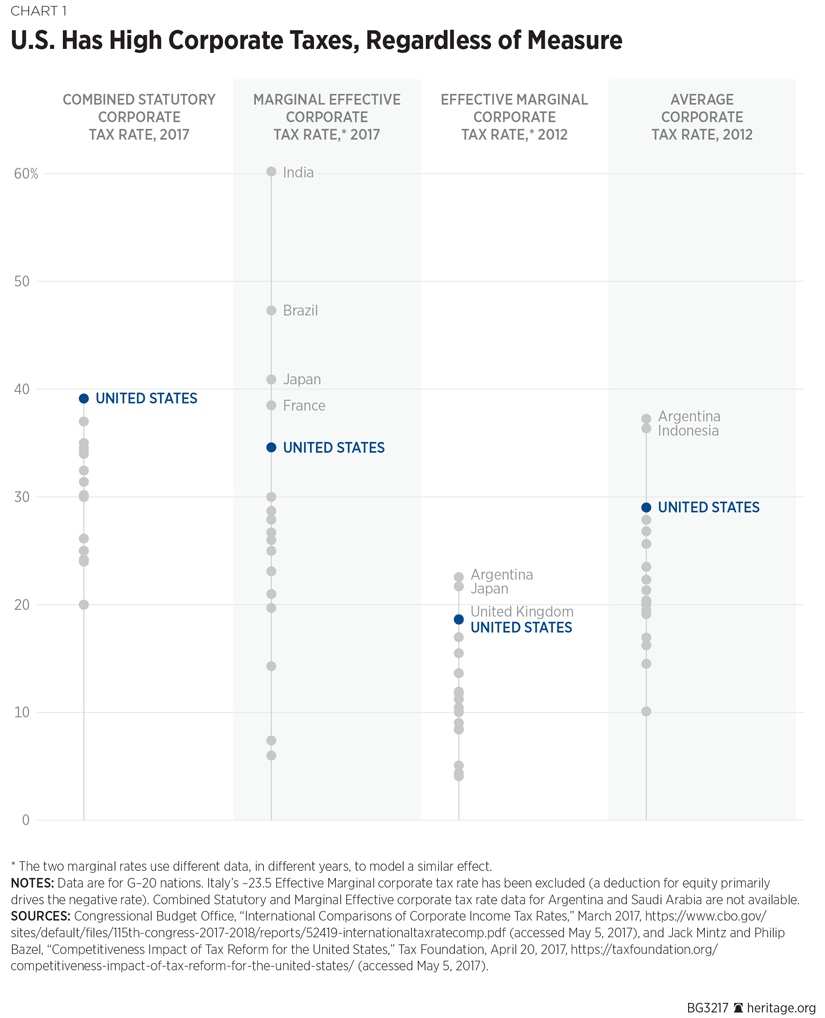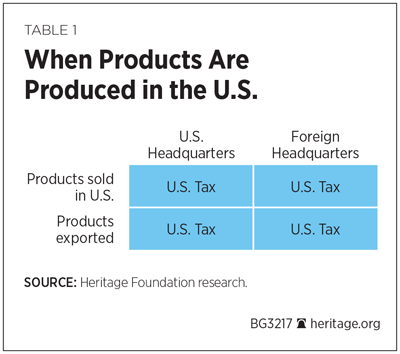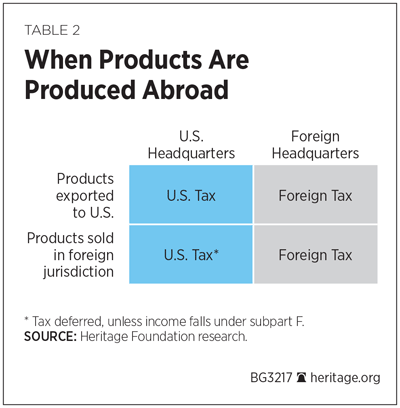The tax reform debate has recently focused on remedying the tax disadvantages faced by U.S. companies. The additional tax burden on U.S. business is primarily a function of an unusually high corporate-income-tax rate. Focusing too much on other countries’ varied tax systems or fundamentally changing the U.S. corporate income tax misses the straightforward remedy of simply lowering the U.S. corporate-income-tax rate, and taxing only domestic income.
Internationally Uncompetitive
An unusually high corporate income tax leaves U.S. workers and investors, and the economy as a whole, worse off than they should be.[REF] The corporate income tax is a poorly designed tax, which biases the whole tax system against savings and investment. This bias makes it harder for businesses to invest in things like new equipment, factories, and research and development. Less investment and smaller capital stocks make it more difficult for the economy to expand, limiting job creation and wage growth.
Chart 1 shows various different measures of the corporate income tax, but there is one clear takeaway: By each measure, the United States ranks consistently as one of the worst.[REF] The combined statutory rate is the legislatively enacted federal tax rate plus an average of state rates. Average tax rates measure taxes paid as a share of corporate income, and the two different measures of effective marginal rates are different imputed measures of the tax burden on a marginal investment. In addition to the high statutory rate, a significant secondary driver of the United States’ high marginal effective tax rate is the system of capital-cost recovery. Full expensing, discussed under “Policy Reforms” below, should be paired with rate reforms. The statutory rate will be used throughout the remainder of the brief, but a similar story could be told using any other measure, as Chart 1 shows that the U.S. is near the top in every measure.

How Is International Income Taxed? Corporate income taxes are levied based on incredibly complex rules that govern where firm profits are earned. In a simple model, there are two types of firms to consider: American firms (headquartered in the U.S.) and foreign firms (headquartered abroad). A territorial corporate income tax falls on U.S. production, which means a country’s chosen tax rate can change the relative attractiveness of foreign versus domestic production. The U.S. worldwide system, paired with high tax rates, biases businesses—both American and foreign—against headquartering in the U.S.

U.S.-Based Production
If any business produces its goods in the U.S. its factors of production (labor and capital) bear the U.S. corporate tax, regardless of where the firm is headquartered or where the product is consumed. Because the U.S. corporate tax is higher than in most other countries, U.S.-based production is artificially made less profitable than foreign-based alternatives, which lowers business investment in the U.S. Less investment places downward pressure on the U.S. capital stock, which results in lower output and wages.
In reality, actually determining the source of a multinational firm’s (those with subsidiaries in other countries) profits is a challenging task for tax administrators. In a world with perfect information, income would be sourced to the proper jurisdiction, and taxes would be levied as described in Table 1. In reality, the system of income sourcing is highly imperfect and allows firms with subsidiaries in other tax jurisdictions to pay less than the full U.S. tax. High U.S. corporate taxes increase the incentive to shift profits to other countries. This results in the right side of Table 2 (foreign-headquartered firms) paying lower, often significantly lower, average taxes than their U.S.-headquartered counterparts.
Similar to the foreign firms, profit-shifting is often a strategy used by U.S.-headquartered firms if they have foreign subsidiaries. For example, Ireland has a 12.5 percent corporate-income-tax rate, so if a U.S. business can attribute some additional profits to a valuable patent owned by an Irish subsidiary, it may be able to lower its U.S. tax bill. Assuming aggressive income shifting, economist Gavin Ekins estimates that a 15-point reduction of the corporate-income-tax rate to 20 percent could raise an additional $74 billion in revenue, purely from income being attributed to the United States.[REF] U.S. firms that are fully domestic must pay the full U.S. corporate tax, and their U.S. factors of production bear the full cost of the U.S. corporate income tax. A lower U.S. corporate tax rate would significantly reduce the incentive to shift U.S. tax liabilities to other jurisdictions, increase profit shifting into the U.S., and largely mitigate inequities between multinational and entirely domestic firms.
Production Abroad
If a good is produced in another country by a firm that is headquartered in the U.S., the profits are taxable in the U.S., whether deferred or paid currently, no matter where the final product is sold. A similar foreign firm’s profits, headquartered in the jurisdiction of production, are only taxable under the foreign government’s territorial corporate tax. Because the U.S. corporate tax is higher than in most other countries, and is levied on worldwide income, foreign production and foreign headquarters are often more attractive than the U.S. alternative.

The U.S. system of worldwide taxation attempts to tax all U.S. corporate profits, even those earned in other countries. To avoid taxing the same income twice, a credit is allowed for taxes paid to other countries. U.S.-headquartered firms with foreign subsidiaries are at a disadvantage because they are expected to pay the U.S. corporate tax rate, which usually exceeds the rate payed by their competitors in other jurisdictions. To mitigate this harm, the U.S. allows firms to defer paying taxes on foreign profits that are held overseas. Under current law, tax is only due on those profits if they are repatriated (brought back to the U.S.). Currently, more than $2.5 trillion of U.S. corporate profits are trapped overseas.[REF]
Reacting to both the high U.S. corporate-income-tax rate and worldwide taxation, U.S. firms are pressured to merge with foreign competitors and move their new joint headquarters overseas to avoid the U.S. tax system. Prominent examples include Anheuser-Busch’s acquisition by Belgian brewer InBev, and Burger King’s buyout of Canadian Tim Hortons.[REF] U.S.-foreign mergers always reincorporate outside the U.S. Even if the merger is not explicitly tax motivated, the decision to not headquarter in the U.S. certainly is tax motivated.
The U.S.-headquartered firm in Table 2 is often able to use its foreign subsidiary to delay paying U.S. taxes and better compete abroad. To the extent that U.S. corporations, with less-sophisticated tax-planning operations, are not able to keep profits earned in foreign markets offshore, those businesses face a higher tax rate than their competitors.
The primary additional tax burden on U.S. business and production exists where the U.S. corporate income tax exceeds that of other countries. The disadvantages faced by U.S. production are self-imposed. Simply lowering the U.S. corporate-income-tax rate would place American business on a more equal tax footing with foreign competitors.
Sales and Value-Added Taxes (VATs). When comparing the international treatment of goods produced by U.S. businesses, it is easy to conflate the corporate income tax with other taxes, such as foreign VATs, which are also collected at the corporate-entity level. However, VATs are more similar to U.S. sales taxes than the current corporate income tax and are largely irrelevant in determining how international income is taxed, as they fall largely on consumption within a country’s borders.
A VAT is a type of consumption tax that is economically similar to a sales tax, levied on final consumption. VATs are border-adjusted, which means that the tax is levied on all imports and removed from all exports. Although under a simple analysis, border-adjustable taxes may appear to implement a tariff-like tax on imports and a subsidy for exports, this is misleading.[REF] The symmetric border adjustment does not distort trade like a tariff, but instead ensures that domestic consumption bears the tax.[REF]
In much the same way that sales taxes and corporate income taxes are separate tax systems, any analysis should be equally careful to distinguish between foreign VATs and corporate income taxes.
Policy Reforms
To make the U.S. a more attractive place to do business, tax reform should lower the corporate-income-tax rate, allow the immediate deduction of capital expenses, and move toward a territorial tax system. These three reforms have the potential to dramatically increase new investment, wages, output, and jobs.
Reduced Rates. Lowering the corporate-income-tax rate is necessary for a more equal treatment of U.S.-headquartered firms. Lowering the U.S. corporate tax rate to, or below, the international average would largely even the playing field, allowing U.S. firms to compete with foreign firms.
A U.S. federal corporate tax rate of 20 percent is the upper bound for global tax competitiveness. Adding in average state tax rates to a 20 percent rate, a U.S. combined rate of about 24 percent would put the U.S. above the worldwide average of 22.5 percent, on par with the Organization for Economic Co-operation and Development (OECD) average of 24.2 percent, and below the Group of 20 (G20) average of 28.5 percent.[REF] A 24 percent combined rate would make the U.S. competitive with China, and more competitive than Mexico.
The corporate income tax should ultimately be eliminated, but a federal rate lower than the 12.5 percent of Ireland (lowest in the OECD) would make America a leader in business tax rates and go a long way toward benefitting U.S. consumers, workers, and investors.
Territorial Taxation. Worldwide taxation puts all U.S. firms competing abroad at a disadvantage to similar firms in almost every other country because their income is taxable at the high U.S. corporate rate. The U.S. should move to a territorial tax system under which the U.S. would not collect additional taxes on foreign-earned profits when distributed back to the U.S. headquarters. This simple change would allow U.S. firms to compete abroad through foreign subsidiaries without the additional burden of U.S. taxes.
Expensing. Lowering tax rates is necessary if America wants to compete for global business. If America wants to win the competition for global business, tax reform should include full expensing. The current U.S. tax system discourages capital investment by decreasing its economic value and creating unnecessary complexity by requiring capital expenditures to be deducted over an often arbitrary number of years, a system known as depreciation. Full expensing removes this complexity and allows businesses to write off all expenditures in the year they are purchased—encouraging investment, job creation, and economic growth by treating all business costs equally.[REF]
High corporate tax rates burden all U.S. businesses, falling especially directly on businesses with limited or no international operations. Rather than searching for novel ways of taxing businesses, the simple policy solution is to reform the current system. A lower corporate-income-tax rate, immediate deduction of capital expenses, and a territorial tax system would allow the economy to grow, creating jobs and increasing wages.
—Adam N. Michel is a Policy Analyst in Tax and Budget Policy in the Thomas A. Roe Institute for Economic Policy Studies, of the Institute for Economic Freedom, at The Heritage Foundation.



